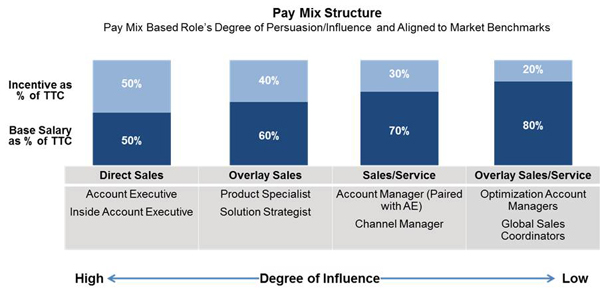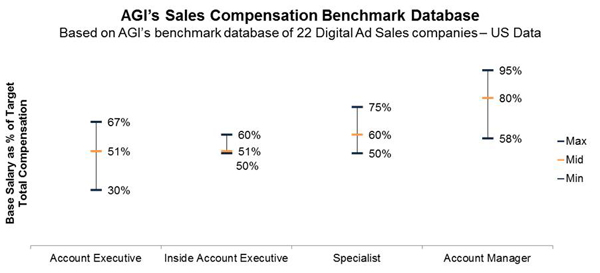Setting Pay Mix with a Structured Approach
How do you set pay mix?
Does your company have many different pay mixes across the organization? How do you determine pay mix for new roles? Does every leader in your organization want a different pay mix for their roles based on their own philosophies? See if any of these quotes sound familiar…
– Sales Leader: “We all work together as a team and help each other out, so most of their pay should be in their salary.”
– Product Specialist Leader: “I want to attract ‘hungry’ specialists that drive our product offerings. They should have the same pay mix as the sellers they support.”
– Sales/Service Leader: “Our Reps are sitting side-by-side with their assigned seller, so they should have the same pay at risk and upside opportunity as the sellers they support!”
Alexander Group recommends the following solution—Develop guiding principles and a pre-defined structure for setting pay mixes.
A Digital Ad Sales Story
We recently worked with a Digital Ad Sales company to help them reign in wide variances in pay mixes. This was causing a number of problems including role ambiguity, pay inequity for similar performance, and morale issues. We recommended the following guiding principle: “Pay Mix is based on the role’s degree of persuasion/influence in the sales process and aligned to market benchmarks to recruit and retain top talent.” We then developed a pay mix structure for them (outlined below). To develop the structure, we grouped roles into categories based on their level of persuasion/influence and then referenced market benchmark data to make sure we were on target. They immediately put it to use to design a plan for a new Solution Strategist role. Some leaders were questioning whether the role’s pay mix should be 50/50 or 60/40 (base/incentive). We mapped the degree of persuasion and influence in the sales process for this role to our Pay Mix Structure. Given that the role did not own the final close of the deal, we aligned it with the Product Specialist role with a 60/40 pay mix.
Leveraging Market Benchmarks
Reliable benchmark data is a key input into designing and using an effective pay mix structure. We leveraged the Alexander Group’s database of Digital Ad Sales companies to provide this particular client with clear insights on how the market treated these different roles (see results in chart below). Market data serves as a wonderful reference, but it should not necessarily dictate the final solution. How companies set their pay mix may differ based on pay philosophy, solution set, job definition, and/or deployment methods. As an example, pay mix benchmarks for the Account Manager role range from 58/42 to 95/5. In some instances, the Account Manager role should be on the same plan structure as the primary selling role (58/42 or similar). However, in other instances the Account Manager role is actually more of a sales coordinator role and therefore does not have much influence in the sales cycle (90/10 or similar). The median is 80/20. In the case of this Digital Ad Sales client, we recommended a pay mix of 70/30. This was based on independent sales responsibilities the Account Managers carry in addition to their job supporting their assigned sellers.
Role Decontamination
Setting the proper pay mix for this position had other benefits as well. It helped the client realize that this role needed to be “decontaminated” from some of the low value, non-selling activities it was carrying in order to be successful. The company decided to offload some of the reporting, insertion order entry, and support activities to other support resources as well as upgrade and train the role to take on more selling activities.
Conclusion
When it comes to sales compensation design, even an aspect as straightforward as pay mix, there is no shortage of opinions. Letting leaders decide on their own what’s appropriate for their teams will inevitably lead to a wide range in pay mixes and a host of potential downstream problems. There are several benefits to having and properly using a set of sales compensation guiding principles and a pay mix structure, including:
– Role clarity
– Pay equity for similar performance
– Consistent and faster decision making

Learn More
Learn more about the Alexander Group’s sales analytics services or contact us today.

